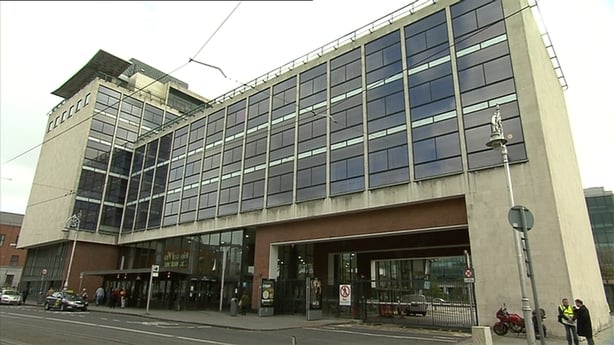After more than 70 years, friends Jim Coffey and Tony Holland share their memories of helping build Busáras.
Before they worked on the construction of Busáras together, they were school friends.
"We were in the same class together," said Mr Holland, who turned 91 in September.
"And we lived fairly close to each other," added Mr Coffey, who is a few months his junior.
Indeed, Mr Holland said that it was he who got Mr Coffey into the glass business.
We need your consent to load this rte-player contentWe use rte-player to manage extra content that can set cookies on your device and collect data about your activity. Please review their details and accept them to load the content.Manage Preferences
"I started in in 1946 and he started in 1947," Mr Holland said.
"I called to his house, because I lived behind him, and I brought him into work, do you remember that?" he asked his friend of many decades, as the two sit side-by-side in the concourse of Busarás.
"Indeed I do," Mr Coffey replied.
"I started in handling glass and then, as you got experienced, you started to move out to the glazing and (Busáras) would have been one of the first jobs I was on for glazing."
And it did not get much bigger than this.
Read more: Wheeling in the years: Busáras celebrates 70th anniversary
Conceived when Ireland was on the brink of becoming a republic, the aim was to deliver a purpose-built national bus station in a complex that was also home to Europe's first post-war office building.
There was even a theatre space in the station's basement, where the Eblana Theatre operated from 1959 to 1995.

Construction of Busarás started in 1945, and after some delays and even a pause in construction for a time, it was completed by 1953.
Indeed Mr Coffey said that one of his bosses had reservations about taking on the contract amid concerns that the job was too ambitious.
"You could lose everything... but the other man said 'no we're going ahead with it', and it was the best move he ever made."
The two men were invited to Busáras to celebrate its 70th anniversary and both men describe how proud they are to have worked on the project.
"All you could hear out of the people was ‘that job down there, it's not a millimetre out’... people were amazed," Mr Holland said.
"Everything was absolutely perfect," Mr Coffey agreed.
"Very often (on other jobs) you would get a window frame slightly off, and you'd have a square pane of glass that you'd be trying to get into it, it was a problem, but here everything fitted absolutely perfect."
They both say that the office building pioneered an early version of double glazing, using two single panes of glass, while the windows surrounding the station concourse presented a different challenge given the scale of panes.
"Just sitting here now looking at the height of those plates (of glass), they were all man handled into position. Nowadays you'd have a sucker hooked on and a machine lifting it up," Mr Coffey said.
"And still we lived to be 90," Mr Holland replied.






